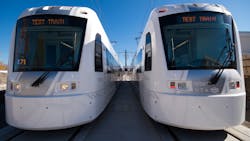Elected officials and Utah Transit Authority representatives held a commemoration ceremony April 8 celebrating the completion of the S-Line streetcar double track construction project.
UTA’s S-Line, which connects the Fairmont Station in Sugarhouse to the Central Point TRAX/Bus station in South Salt Lake City, began operating in December 2013 with 20 minute headways on a single track. Since its debut, the S-Line has seen ridership increase 60 percent and the double track project was a way for service along the line to improve. Ground was broken on the double track project in June 2018 and the completed project will allow UTA to provide 15 minute service along the S-Line. Additionally, UTA says the $5.9 million project will decrease time spent waiting for trains, reduce congestion, improve air quality and provide better connections with UTA’s other modes of transportation.
UTA Board of Trustees Chair Carlton Christensen, christened the new stretch of double tracks and proclaimed, “The S-Line unofficially stands for success and starting Sunday it will also stand for speed. We hope the public will come out and take advantage of this.”
According to Salt Lake County Mayor Jenny Wilson, “In the 1990s, there was incredible resistance to the idea of incorporating rail service into our public transit system. But there were leaders who stood up and the public at large really did favor this idea of investing in rail. Fast forward to today, we’re seeing revitalized communities due to rail. UTA is helping us create an amazing web of transit throughout Salt Lake Valley.”
UTA explains that since the S-Line began running five years ago, the South Salt Lake and Sugar House areas of Salt Lake City have experienced significant growth, with the addition of more than 1,000 residential units and more than 2 million square feet of redevelopment.
South Salt Lake Mayor Cherie Wood said, “South Salt Lake has become a desirable place to call home. Amenities like the S-Line double track make it even more desirable.”
Ground was broken on June 11, 2018 on the new section of double track from 300 East to 500 East. The completion of construction makes 15 minute frequency possible on the S-Line, decreasing time spent waiting for trains, reducing congestion, improving air quality and providing better connections with UTA’s other modes of transportation. This improvement in service is also anticipated to encourage more residential and commercial development.
The two block stretch of double track, which runs from 300 East to 500 East, was made possible by $4 million dollars in Salt Lake County Infrastructure funding and $1.9 million dollars from the Wasatch Front Regional Council Congestion Mitigation and Air Quality Improvement program grants. The county is also pledging $500,000 for additional operating costs for the first three years of double track service.UTA says this investment is estimated to attract approximately 1,000 additional daily passengers by 2030; the line now averages 1,369 weekday boardings.
About the Author

Mischa Wanek-Libman
Group Editorial Director
Mischa Wanek-Libman is director of communications with Transdev North America. She has more than 20 years of experience working in the transportation industry covering construction projects, engineering challenges, transit and rail operations and best practices.
Wanek-Libman has held top editorial positions at freight rail and public transportation business-to-business publications including as editor-in-chief and editorial director of Mass Transit from 2018-2024. She has been recognized for editorial excellence through her individual work, as well as for collaborative content.
She is an active member of the American Public Transportation Association's Marketing and Communications Committee and served 14 years as a Board Observer on the National Railroad Construction and Maintenance Association (NRC) Board of Directors.
She is a graduate of Drake University in Des Moines, Iowa, where she earned a Bachelor of Arts degree in Journalism and Mass Communication.
